|
|
 |
 |
EDUCATION - Stuff for Kids

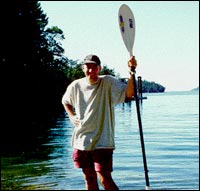 |
Kevin
Conley on a kayaking trip along the west coast of Canada.
| THE BIRTH OF A COLD WATER
REEF
Iím Kevin Conley and I work with a marine
oceanography project called Sidney Pier Artificial Reef Science
[Fig.1] in Canada. This is a really fun project for me because I
studied biology and I like working with oceans and with people; plus
itís great to be doing something for the environment. Itís also an
exciting project because it is a non-profit project involving the
community and several local organizations as volunteers and
fund-raisers participating in ocean science. In 1996, a reef was
built from artificial materials and we are monitoring the
colonization of animals [Fig. 2] and plants onto the new environment
to evaluate improvements in the marine life habitat.
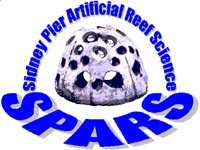 |
Figure
1. Official logo of Sidney Pier Artificial Reef Science
| Our project is located in Sidney
which is a small town on Vancouver Island in British Columbia,
Canada [Fig. 3]. The Town of Sidney built a pier and wanted to
improve the shrimp and crab fishing, as well as have a near-by area
for SCUBA divers and for nature viewing. So the town built the reef
as habitat - a place for organisms to find food, shelter, and for
some, a place to fasten themselves onto - to attract more marine
organisms to the area around the pier [Figs. 4]. One of the things
that limits fish is habitats; different fish require different
habitat; but all fish do well in areas where they can hide and a
find a good food source. People discovered the value of reefs as
habitat by exploring and fishing on natural rock reefs and coral
reefs, finding both more fish and different varieties of fish and
other animals and underwater plants (called algae). People in Japan
learned about the advantages of artificial reefs centuries ago by
observing that they catch more fish in the area of a shipwreck.
Since then, Japan has put a lot of work into developing artificial
reefs, and the rest of the world has begun to join in. So, to try
and increase the richness of the underwater environment in Sidney we
built a reef about 10 meters under the surface of the ocean from 270
Reef Balls weighing 170-340 kg and measuring approximately 0.91 x
0.61 meters [Fig. 5].
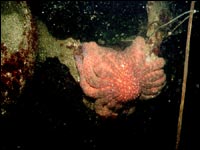 |
Figure 2. One of the first inhabitants of the
reefs, the sunflower seastar (Pycnopodia helianthoides).
P. helianthoides is said to be the largest and fastest
seastar, reaching a diameter of over 1 m (with up to
about 24 Ďarmsí) and speeds of 1 m per minute (pretty
fast in seastar terms). | |
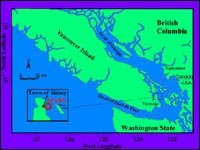 |
Figure 3. Map showing Sidneyís location.
| |
The balls are made of environmentally stable concrete mixtures,
and provide habitat for fish, crabs, shrimp, and many other marine
plants and animals. The water is cold here, about 8 - 12įC in the
summer (according to current data). This is why coral reefs do not
live here, but there are lots of rocky reefs around Vancouver
Island. The cold water is rich in nutrients, and strong currents
bring these nutrients (as well as larval plants and animals, mostly
in the spring) to the reef. We expect that our reef will be home to
a large number of marine organisms.
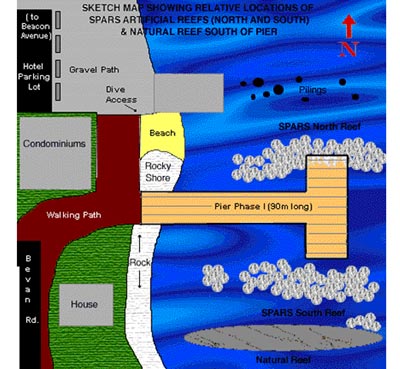 |
Figure
4. The SPARS survey area showing relative positions of the
Reef Ball reefs (north and south of the pier) and the natural
reef we are studying as a control comparison (south of the
Reef Ball reef that is south of the pier).
|
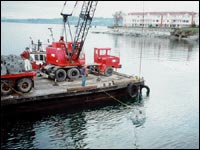 |
Figure 5. Reef Balls being deployed (November 13,
1996) for the reefs that SPARS monitors. 270 Reef Balls
were placed in the water in two strips (one on each side
of the pier) by crane off of a floating barge.
| |
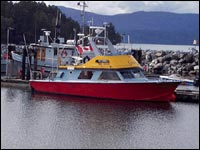 |
Figure 6. One of the ships used to perform
acoustic swath (mapping) surveys of the SPARS reefs,
called the MV Revisor (a Canadian Hydrographic Service
vessel). | |
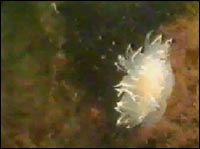 |
Movie
of the reef from Mar 6 and May 1, 1997.
| Local experts worked together to
design the methods for making the observations used in monitoring
the colonization of life onto the new reef [Movie]. They also had to
decide what organisms we should look for, because even the experts
canít identify everything underwater, especially without removing it
from the reef. Then we had to teach the volunteer divers how to make
the observations needed to find out if the reef is improving marine
habitat. SCUBA volunteers, as young as 13, have been diving on the
reef recording observations on waterproof paper and taking video
along transects (straight sampling lines along the reef) as the
plant and animal life have developed this past year. It is very
exciting to see the colonization of the environment over such a
short length of time.
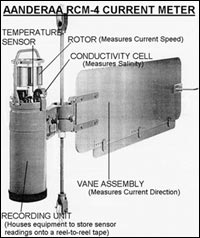 |
Figure
7. The instrument (Aanderaa RCM- 4) used to record current,
temperature and salinity for the waters adjacent to the SPARS
monitored reefs. | Not only are we
watching for plants and animals moving onto the reef, but we are
also studying the reefís ocean environment. We mapped the reef with
an acoustic swath survey which involves several complex computing
systems that bounce sound waves off the ocean floor from aboard a
boat [Fig. 6]. We then use these data to calculate ocean bottom
characteristics, location and water depth information. These
acoustic surveys are how nautical charts (maps that show the depth
of the ocean and the coastline) are made that allow boaters to
navigate safely. Water properties, such as temperature, salinity and
currents, are continually being measured by a current meter that is
fastened to the reef [Fig. 7]. The properties of the water are
important because they help determine what animals and plants can
live on the reef. For example, currents act to bring food and
nutrients to the reef life, carry in new plants and animals to
colonize the reef, and exchange water.
In 1998, International Year of the Oceans, we will continue to
make the underwater video movies of the reef so that students in the
local schools can watch new species colonize the reef [Fig. 8]. We
look forward to watching the reef grow with even more plants and
animals, and towards involving more members of the community in the
project. Watch for our progress, partners and volunteers on
http://www.nwis.bc.ca/spars/
Acknowlegements:
Copyrighted video footage
was used with permission from the Royal British Columbia Museum for
this section of the Year of the Oceans CD.
The SPARS project is a volunteer community project and would like
to thank all of its volunteers and partners who have made the
project a success. For a detailed, up to date list of these people
and for more information on the project in general, please browse
our web site. SPARS is currently a Science and Technology Youth
Internship partnership between World Aquatic Sports Ltd. and the
Canadian Department of Fisheries and Oceans. Much support has also
been received from over 40 volunteers as well as our partners at the
Royal British Columbia Museum, Eco-Ed Environmental Youth Team, The
Town of Sidney, Reef Ball Development Group Ltd., Frank Whiteís Dive
Stores, and the Professional Association of Diving Instructors.
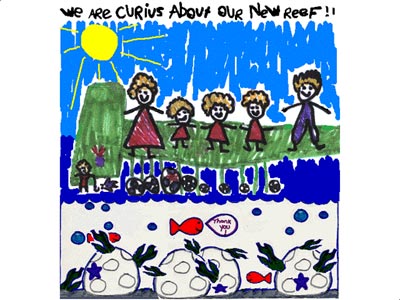 |
Figure
8. A modified version of a picture that a local school girl
(Elizabeth Bell, grade 1) drew (the top half) after visiting
the Bevan pier. Her picture was added onto at the bottom by
picture from another local school girl (Kate, grade 7).
|
|
 |
Overview
| Science
| Technology
| Missions
| Newsroom
| Education | Gallery
| |





